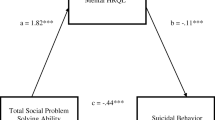Abstract
Intimacy and its contribution to life satisfaction have not been explored among institutionalized elders. We studied residents of a Veterans Affairs nursing home and assessed cognitive and physical function, life satisfaction, and importance of intimacy. The Folstein Mini-Mental State, Barthel Index, Life Satisfaction Index-Z, and a series of vignettes were used to assess each domain. Vignettes depicted various scenarios (e.g., recent admission to a nursing home, notification of diagnosis of a terminal disease), and asked the subject to rate the importance of intimate social, intellectual, emotional, or physical interactions. Social intimacy was rated as most important, followed by nonsexual physical, intellectual, emotional, and finally, sexual-physical intimacy (social vs. sexual-physical, p =0.0013). In addition, social (rs =.299, p =0.023), nonsexual physical (rs =.312, p =0.019), and intellectual (rs =.382, p =0.005) intimacy were associated with life satisfaction. Nursing home care providers can enhance resident quality of life through social, intellectual, and nonsexual physical interactions even when the underlying medical, physical, or cognitive deficit cannot be ameliorated.
Similar content being viewed by others
References
Folstein, M. F., Folstein, S., and McHugh, P. R. (1975). Mini-Mental State: A practical method of grading the cognitive state for the clinician.J. Psychiat. Res. 12: 189–198.
Mahoney, F. I.,and Barthel, D. W. (1965). Functional status: The Barthel Index.Maryland State Med. J. 14: 61–65.
Maslow, A. H. (1970).Motivation and Personality 2nd ed., Harper & Row, New York.
Neugarten, B. L., Havighurst, R. J., and Tobin, S. S. (1961). The measurement of life satisfaction.J. Gerontol. 16: 134–143.
Osberg, J. S., McGinnis, G. E., DeJong, G., and Seward, M. L. (1987). Life satisfaction and quality of life among disabled elderly adults.J. Gerontol. 42: 228–230.
Renshaw, D. C. (1984). Intimacy and intercourse.Med. Aspects Hum. Sex. 18: 70–76.
Schaefer, M. T., and Olson, D. H. (1981). The assessment of social intimacy.J. Pers. Assess. 7: 47–60.
Weiss, L. J. (1983).Intimacy and adaptation. In Weg, R. B. (ed.),Sexuality in the Later Years: Roles and Behavior Academic Press, New York.
Author information
Authors and Affiliations
Rights and permissions
About this article
Cite this article
Bullard-Poe, L., Powell, C. & Mulligan, T. The importance of intimacy to men living in a nursing home. Arch Sex Behav 23, 231–236 (1994). https://doi.org/10.1007/BF01542101
Issue Date:
DOI: https://doi.org/10.1007/BF01542101




